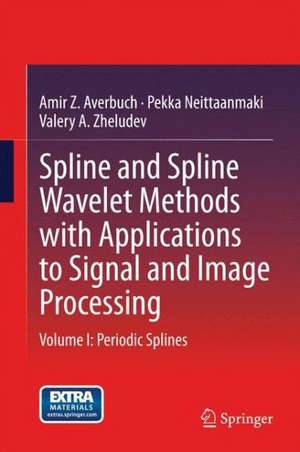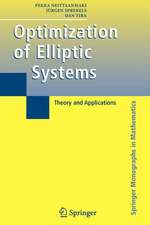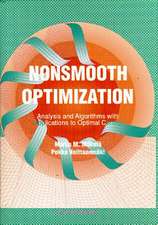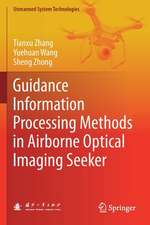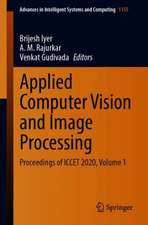Spline and Spline Wavelet Methods with Applications to Signal and Image Processing: Volume I: Periodic Splines
Autor Amir Z. Averbuch, Pekka Neittaanmaki, Valery A. Zheludeven Limba Engleză Hardback – 23 apr 2014
The Matlab software can be downloaded from http://extras.springer.com
Preț: 970.24 lei
Preț vechi: 1183.22 lei
-18% Nou
Puncte Express: 1455
Preț estimativ în valută:
185.70€ • 193.14$ • 155.62£
185.70€ • 193.14$ • 155.62£
Carte tipărită la comandă
Livrare economică 13-27 martie
Preluare comenzi: 021 569.72.76
Specificații
ISBN-13: 9789401789257
ISBN-10: 9401789258
Pagini: 524
Ilustrații: XXV, 496 p. 185 illus., 128 illus. in color.
Dimensiuni: 155 x 235 x 34 mm
Greutate: 1.16 kg
Ediția:2014
Editura: SPRINGER NETHERLANDS
Colecția Springer
Locul publicării:Dordrecht, Netherlands
ISBN-10: 9401789258
Pagini: 524
Ilustrații: XXV, 496 p. 185 illus., 128 illus. in color.
Dimensiuni: 155 x 235 x 34 mm
Greutate: 1.16 kg
Ediția:2014
Editura: SPRINGER NETHERLANDS
Colecția Springer
Locul publicării:Dordrecht, Netherlands
Public țintă
ResearchCuprins
1 Introduction: Signals and transforms.- 2 Introduction: Periodic filters and filter banks.- 3 Mixed circular convolutions and Zak transforms.- 4 Periodic polynomial splines.- 5 Polynomial smoothing splines.- 6 Calculation of splines values by subdivision.- 7 Spline algorithms for deconvolution and inversion of heat equation.- 8 Periodic spline wavelets and wavelet packets.- 9 Discrete-time periodic wavelet packets.- 10 Deconvolution by regularized matching pursuit.- 11 Block-based inversion of the heat equations.- 12 Hydro-acoustic target detection.- 13 Periodic discrete splines.- 14 Discrete periodic spline wavelets and wavelet Packets.- 15 Biorthogonal wavelet transforms.- 16 Biorthogonal wavelet transforms originating from splines.- 17 Wavelet frames generated by spline based p-filter banks.- 18 Application of periodic frames to image restoration.- Appendix: Guide to SplineSoftP.- Glossary.- Index.
Recenzii
“The purpose of this book is to thoroughly prepare the reader for a research in spline and spline wavelet methods to signal and image processing theory at an advance level. … The book is a textbook for graduate students and one of the major consulting reference for the researcher in the field of spline wavelet theory and image processing.” (Haydar Akca, zbMATH 1316.65019, 2015)
Notă biografică
Amir Averbuch is a professor of Computer since 1987 in the School of Computer Science, Tel Aviv University. He is also the founder and CSO of ThetaRay LTD. He got his B.Sc and M.Sc in mathematics from the Hebrew University in Jerusalem in 1968, 1975, respectively, and a PhD in computer Science from Columbia University in 1983. He has over 30 years of experience in research and development in academia and industry. Between 1977-1986 he was research staff member in IBM T.J. Watson Research Center, Yorktown Heights. New York. His research interests include applied and computational harmonic analysis, big data processing and analysis, cyber security, signal/image processing, Wavelets, scientific computing He was visiting professor in many places. He has supervised 102 M.Sc. 19 PhD and 13 post-doc students. He has published 198 papers in refereed journals, 170 papers in conferences, 10 chapters in books and 20 patents.
Pekka Neittaanmäki is Professor in Scientific Computing and Dean of the Faculty of Information Technology and Head of COMAS (Computing and Mathematical Sciences) Graduate School at the University of Jyväskylä, Visiting Professor at the Tokyo Institute of Technology, Japan, and Adjoint Professor at the University of Houston, USA. His research interests are mathematical and numerical modeling, signal analysis, data analysis, optimization and optimal control. He is the author or co-author of more than 300 publications in various parts of nume
rical analysis and applied mathematics including 14 books. He has supervised more than 80 PhD theses. He has participated in many industrial projects in Finland and Europe including among others paper machine, telecommunication, process industry as well as medical diagnostics applications.Valery A. Zheludev, received his M.S. degree on Math. Physics from St. Petersburg State University, Russia. He received Ph.D. degree on Math. Physics from Steklov Math. Inst. of Acad. Sci. USSR and the prize "For the best Ph.D thesis" at St. Petersburg University. He received Dr. Sci. degree (habilitation) on Comput. Math. from Siberia Branch of Acad. Sci. USSR. Took positions from Lecturer at Pedagogical Univ., St. Petersburg, to full Professor at St.-Petersburg Military Institute for Construction Engineering. In 1995 he moved to Israel, where took positions from Researcher to Associate Professor at the School of Computer Science, TelAviv University, Israel. Currently, he is retired from the Associate Professor position and is working as a Researcher at the RAMOT company, which is a research branch of Tel Aviv University. Starting from 2010 he is working as a Senior Researcher at the Dept. of Mathematical Information Technology, University of Jyvaskyla, Finland.
Fields of research:|
Wavelet and Frame Analysis, Approximation Theory, Signal and Image Processing, Hyperspectral Processing, Geophysics, Pattern Recognition, Target Detection, Medical Imaging.
Participa
ted in many industrial research projects in Israel and Finland in cooperation with the Israeli Ministries of Defense and Sciences and with companies such as Paradigm Geophysical Ltd, Waves Audio Ltd, Bar-Kal Systems Engineering Ltd, ELTA Systems Ltd., Applied Materials, Orbotech, Nova, ElOp, Elta, Metso, Patria Aviation, TietoSaab.
Pekka Neittaanmäki is Professor in Scientific Computing and Dean of the Faculty of Information Technology and Head of COMAS (Computing and Mathematical Sciences) Graduate School at the University of Jyväskylä, Visiting Professor at the Tokyo Institute of Technology, Japan, and Adjoint Professor at the University of Houston, USA. His research interests are mathematical and numerical modeling, signal analysis, data analysis, optimization and optimal control. He is the author or co-author of more than 300 publications in various parts of nume
rical analysis and applied mathematics including 14 books. He has supervised more than 80 PhD theses. He has participated in many industrial projects in Finland and Europe including among others paper machine, telecommunication, process industry as well as medical diagnostics applications.Valery A. Zheludev, received his M.S. degree on Math. Physics from St. Petersburg State University, Russia. He received Ph.D. degree on Math. Physics from Steklov Math. Inst. of Acad. Sci. USSR and the prize "For the best Ph.D thesis" at St. Petersburg University. He received Dr. Sci. degree (habilitation) on Comput. Math. from Siberia Branch of Acad. Sci. USSR. Took positions from Lecturer at Pedagogical Univ., St. Petersburg, to full Professor at St.-Petersburg Military Institute for Construction Engineering. In 1995 he moved to Israel, where took positions from Researcher to Associate Professor at the School of Computer Science, TelAviv University, Israel. Currently, he is retired from the Associate Professor position and is working as a Researcher at the RAMOT company, which is a research branch of Tel Aviv University. Starting from 2010 he is working as a Senior Researcher at the Dept. of Mathematical Information Technology, University of Jyvaskyla, Finland.
Fields of research:|
Wavelet and Frame Analysis, Approximation Theory, Signal and Image Processing, Hyperspectral Processing, Geophysics, Pattern Recognition, Target Detection, Medical Imaging.
Participa
ted in many industrial research projects in Israel and Finland in cooperation with the Israeli Ministries of Defense and Sciences and with companies such as Paradigm Geophysical Ltd, Waves Audio Ltd, Bar-Kal Systems Engineering Ltd, ELTA Systems Ltd., Applied Materials, Orbotech, Nova, ElOp, Elta, Metso, Patria Aviation, TietoSaab.
Textul de pe ultima copertă
This volume provides universal methodologies accompanied by Matlab software to manipulate numerous signal and image processing applications. It is done with discrete and polynomial periodic splines. Various contributions of splines to signal and image processing from a unified perspective are presented. This presentation is based on Zak transform and on Spline Harmonic Analysis (SHA) methodology. SHA combines approximation capabilities of splines with the computational efficiency of the Fast Fourier transform. SHA reduces the design of different spline types such as splines, spline wavelets (SW), wavelet frames (SWF) and wavelet packets (SWP) and their manipulations by simple operations. Digital filters, produced by wavelets design process, give birth to subdivision schemes. Subdivision schemes enable to perform fast explicit computation of splines' values at dyadic and triadic rational points. This is used for signals and images upsampling. In addition to the design of a diverse library of splines, SW, SWP and SWF, this book describes their applications to practical problems. The applications include upsampling, image denoising, recovery from blurred images, hydro-acoustic target detection, to name a few. The SWF are utilized for image restoration that were degraded by noise, blurring and loss of significant number of pixels. The book is accompanied by a Matlab based software that demonstrates and implements all the presented algorithms. The book combines extensive theoretical exposure with detailed description of algorithms, applications and software.
The Matlab software can be downloaded from http://extras.springer.com
The Matlab software can be downloaded from http://extras.springer.com
Caracteristici
Provides a universal toolbox accompanied by Matlab software Can be used as supplementary reading Presents a new generic approach to the wavelets and frames design Includes supplementary material: sn.pub/extras
